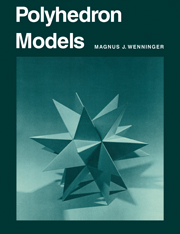Book contents
- Frontmatter
- Dedication
- Contents
- Preface to 1978 reprint
- Preface
- Foreword
- Introduction: uniform polyhedra
- Mathematical classification
- Section I The Convex Uniform Polyhedra: The Platonic and Archimedean Solids
- Section II Some Stellations and Compounds
- Commentary on stellations and compounds of the Platonic solids
- The stellated octahedron (19)
- Stellations of the dodecahedron (20–22)
- Commentary on the stellated icosahedron
- Stellations of the icosahedron (23–42)
- Commentary on the stellation of the Archimedean solids
- Stellations of the cuboctahedron (43–46)
- Commentary on the icosidodecahedron
- Stellations of the icosidodecahedron (47–66)
- Section III Non-convex Uniform Polyhedra
- Epilogue
- References
- List of models
Commentary on stellations and compounds of the Platonic solids
from Section II - Some Stellations and Compounds
Published online by Cambridge University Press: 05 August 2015
- Frontmatter
- Dedication
- Contents
- Preface to 1978 reprint
- Preface
- Foreword
- Introduction: uniform polyhedra
- Mathematical classification
- Section I The Convex Uniform Polyhedra: The Platonic and Archimedean Solids
- Section II Some Stellations and Compounds
- Commentary on stellations and compounds of the Platonic solids
- The stellated octahedron (19)
- Stellations of the dodecahedron (20–22)
- Commentary on the stellated icosahedron
- Stellations of the icosahedron (23–42)
- Commentary on the stellation of the Archimedean solids
- Stellations of the cuboctahedron (43–46)
- Commentary on the icosidodecahedron
- Stellations of the icosidodecahedron (47–66)
- Section III Non-convex Uniform Polyhedra
- Epilogue
- References
- List of models
Summary
The word ‘stellation’ comes from the Latin word ‘stella’ which means ‘star’. There are star polygons as well as star polyhedra. Exactly what this means is best understood by drawings and models rather than by abstract definitions. You can thus begin again with the simplest polygon, the equilateral triangle, and see what happens if you produce each line segment forming its sides. You find that no new portions of two dimensional space can be enclosed. See fig. 17. The lines will forever get farther apart. The same thing happens if you try producing the sides of a square. The lines are in parallel pairs and will never meet to enclose any portion of the plane other than the interior of the original square. See fig. 18. With the pentagon something more interesting begins to happen. The sides of the pentagon when produced will meet and enclose more space exterior to the original pentagon. It turns out to be the well-known five-pointed star, also called the pentagram. See fig. 19. It was known to the ancients, as is evident from the fact that it was used by the Pythagorean brotherhood as a symbol of health. Similarly a hexagon leads to a six-pointed star or hexagram (really not a single polygon but a compound of two equilateral triangles). An octagon leads to an eight-pointed star or octagram; a decagon to a ten-pointed star or decagram. The pentagram, octagram, and decagram can still be considered as single polygons of five, eight, and ten sides respectively, since you can trace out their sides in a continuous movement going around the centre of the figure twice in the case of the pentagram instead of once as in the pentagon. In the figures follow the order of the numerals. In the octagram and decagram a continuous movement will take you three times around the centre.
- Type
- Chapter
- Information
- Polyhedron Models , pp. 34 - 36Publisher: Cambridge University PressPrint publication year: 1971



